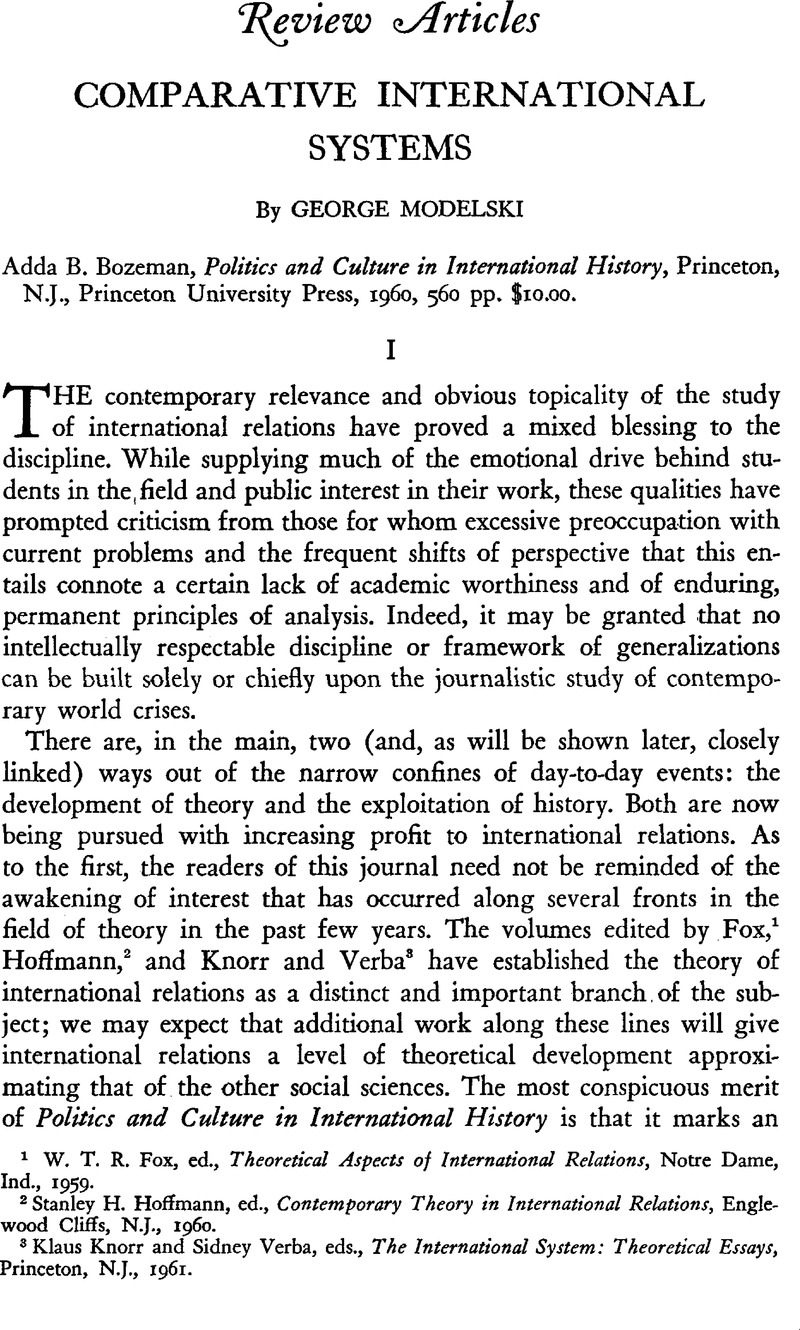Article contents
Comparative International Systems
Published online by Cambridge University Press: 18 July 2011
Abstract

- Type
- Review Articles
- Information
- Copyright
- Copyright © Trustees of Princeton University 1962
References
1 Fox, W. T. R., ed., Theoretical Aspects of International Relations, Notre Dame, Ind., 1959.Google Scholar
2 Hoffmann, Stanley H., ed., Contemporary Theory in International Relations, Englewood Cliffs, N.J., 1960.Google Scholar
3 Knorr, Klaus and Verba, Sidney, eds., The International System: Theoretical Essays, Princeton, N.J., 1961.Google Scholar
4 There are some notable exceptions, all pre-World War II. Schuman's, Frederick veteran International Politics (1st edn., 1933)Google Scholar is built upon the conception of the Western state system and presents, in Book I, outlines of the Near Eastern and Greco-Roman precursors of the Western world. Russell's, Frank M. basic Theories of International Relations (1936)Google Scholar contains, in addition, chapters on ancient China and India. Wright's, Quincy now classic A Study of War (1942)Google Scholar does full justice to premodern warfare. The standard Soviet textbook of international history, Istoriia Diplomatii (Potemkin, W. P., ed., Moscow, 2nd edn., 1959)Google Scholar, has in Part I a sound discussion of the diplomacy of antiquity, but ignores India and the Far East.
5 While dismissing outright the view that international relations is no more than the most up-to-date part of history, another name for contemporary history; die study of international relations stands in the same relation to international history as political science does to political history and economics to economic history.
6 Quite obviously, a student of, say, the Thai-Cambodian dispute over the ownership of the temple of Pra Viharn, or of international disarmament conferences, cannot account for the status or prospects of such issues without going into their historical antecedents.
7 Harsanyi, John C., “Explanation and Comparative Dynamics in Social Science,” Behavioral Science, V (April 1960), p. 139.Google Scholar I would prefer to say that all social science problems have a time dimension, because the historians' history customarily deals in macroscopic time sequences, while for social scientists the earlier periods may frequently be shorter and of a kind not usually subject to historical methods of investigation.
8 The argument for such study is well put in Hoffmann, , op.cit., pp. 174ff.Google Scholar
9 See Kautilya's Arthasastra, trans, by R. Shamasastry, 4th edn., Mysore, 1951, esp. pp. 344–46, 385.
10 “In the most primitive societies the relations between tribes or villages have many of the features of international relations. Unfortunately they have never been studied systematically, which is a pity,” says the author of a textbook on international organization (Reuter, Paul, International Institutions, London, Allen and Unwin, 1958, p. 35).Google Scholar
11 Wright, Quincy, The Study of International Relations, New York, 1955, p. 89.Google Scholar
12 Hypothetical or constructed (e.g., future) systems and simulated systems (e.g., games) of international relations should be regarded as a source of plausible analogies rather than as a field for controlled experiments. However, the working of partial, less inclusive systems (such as foreign policies or alliances) can be observed contemporaneously.
13 “In dealing with the affairs of one country, the concept of the nation as constituting a political entity … permits a synthesis with a clearly defined focus of interests. It scarcely requires to be pointed out that there is no corresponding entity which includes all the political units of the world and peoples of the world.” (Teggart, Frederick J., Theory and Processes of History, Berkeley, Calif., 1960, p. 44.)Google Scholar
14 Fox, W. T. R. and Fox, A. B., “The Teaching of International Relations in the United States,” World Politics, XIII (April 1961), p. 359.Google Scholar
- 3
- Cited by




